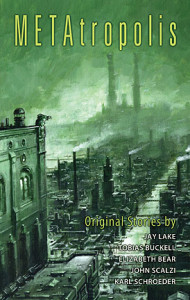 Shared-world projects have what can kindly be referred to as an uneven history. Thieves’ World, Wild Cards, Future Boston, Liavek (complete with possibly the only minnow-headed god in the history of fantasy literature) — all had their ups, downs, and other, less definable moments. METAtropolis, edited by John Scalzi and with a lineup of authors that reads like the Superfriends of who’s hot in science fiction, is the latest attempt at a shared-universe anthology, and it’s one of the most ambitious to date. Rather than being based off a particular setting, it’s predicated on the notion of the future of the city itself. The concept drives the evolution of the continuity between stories, rather than the world bible dictating what concepts make sense at play here. It’s an interesting approach and a daunting one. The bar is set high, and the five authors fling themselves at it with varying degrees of success.
Shared-world projects have what can kindly be referred to as an uneven history. Thieves’ World, Wild Cards, Future Boston, Liavek (complete with possibly the only minnow-headed god in the history of fantasy literature) — all had their ups, downs, and other, less definable moments. METAtropolis, edited by John Scalzi and with a lineup of authors that reads like the Superfriends of who’s hot in science fiction, is the latest attempt at a shared-universe anthology, and it’s one of the most ambitious to date. Rather than being based off a particular setting, it’s predicated on the notion of the future of the city itself. The concept drives the evolution of the continuity between stories, rather than the world bible dictating what concepts make sense at play here. It’s an interesting approach and a daunting one. The bar is set high, and the five authors fling themselves at it with varying degrees of success.
The weakest story of the bunch is also the lead story in the book. Jay Lake’s “In the Forests of the Night” starts to say some interesting things about the notion of the distributed urban center, but it leans too heavily on a metanarrative for the world that never really gets exposed elsewhere in the book. It also owes a heavy and conscious debt to Alfred Bester’s The Stars My Destination, both in narrative structure and in the form of the lead character. The fact that he’s named “Tygre Tygre” — the original title of Bester’s masterpiece — is a graceful acknowledgement of inspiration, but it doesn’t help elevate something that essentially reads like part of a novel into a compelling standalone piece.
Immediately following, however, is one of the book’s real standouts, Tobias Buckell’s “Stochasti-City.” Buckell’s Detroit feels real and believable, and he does a superb job of immersing the reader in this new urban paradigm without dumping blocks of exposition at the slightest provocation. More important, the things his characters do make sense in the context of a Detroit struggling to find a new identity for itself in the wake of global collapse, with old approaches fighting an asymmetrical conflict with the new.
The third story in the anthology, Elizabeth Bear’s “The Red In the Sky Is Our Blood,” is also set in Detroit. However, it’s very much a classic science fiction story. Protagonist notes a secret, protagonist is initiated into the secret, protagonist proves their worth by helping defend the secret. While the story integrates seamlessly into the world as a whole and the characters are well-drawn and appealing, the means by which the protagonist chooses sides feels a bit forced, and the story itself has something of a retro tone that is a sharp contrast to its immediate predecessor.
Story number four belongs to project editor John Scalzi, and it, too, has an old-school feel to it. The cute moment at the beginning of the story is the means by which the wisecracking protagonist saves the day, in a manner that wouldn’t be out of place in old-school Analog piece. Where the story fails the worst is in the explication of the sociological pressures on the resurgent New St. Louis; where it shines is in how it exploits those pressures in the attack on the city that the hero must repulse. Here, Scalzi connects best with the notion of the re-evolved city and its interaction with the new social dynamics that needs must go along with them. It’s just disappointing that the story starts and finishes with something that feels more Silver Age than Electronic Age.
METAtropolis wraps up with the other absolute gem, “To Hie From Far Cilenia” by Karl Schroeder. If there’s a fault to this piece of international intrigue, shifting virtual identities, and levels of perception, it’s that it leapfrogs the notion of the evolved city and jumps straight to next-generation concepts of nations and indeed worlds. Using ARGs (Alternate Reality Games) as a way in to his world of reality piled on top of virtual reality, Schroeder presents something jaw-droppingly ambitious and stunningly well executed. Starting from the hoariest of espionage plots — missing fissionable materials — he jumps from radioactive reindeer to the middle of the ocean to a steampunk Atlantis with daredevil aplomb. This story more than lives up to the promise of the project, and it’s a satisfying and appropriate closer to the book.
(Subterranean, 2009)
